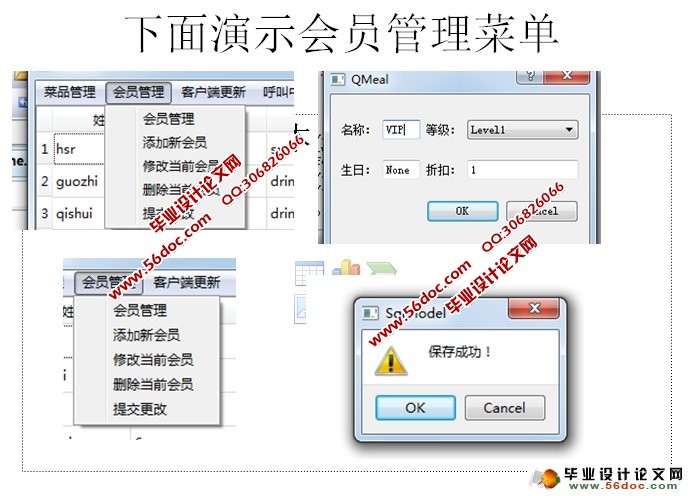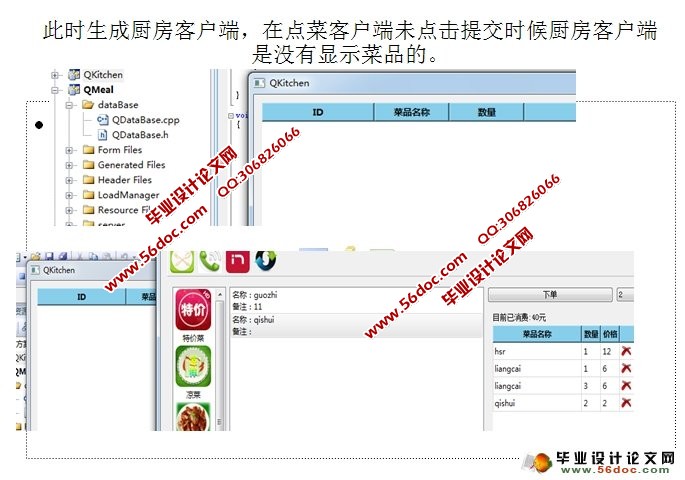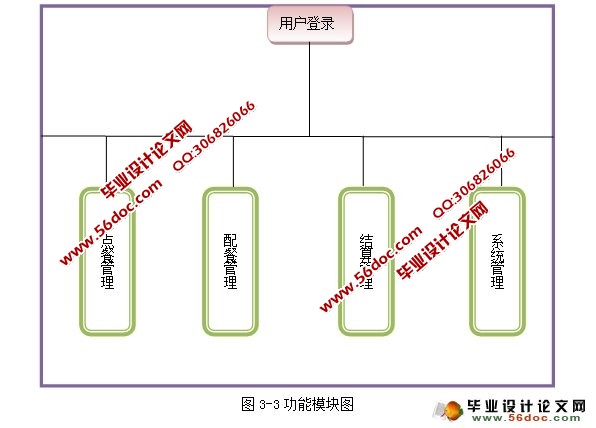基于QT的电子点餐订餐系统的设计与实现(SQLite)(任务书,外文翻译,毕业论文20000字,程序代码,SQLite数据库,答辩PPT)
摘 要
在深入研究中小餐饮企业工作流程的基础上,分析制约餐饮企业工作效率的各种因素,发现影响效率的主要因素是普遍使用手工登记菜谱的现象,本系统运用计算机系统来实现餐饮企业工作流的信息化管理,采用面向对象的开发方法以及C++语言,依靠Visual studio2008作为开发工具,使用Sqlite网络数据库存储数据。实现了客户点餐、厨师配餐、收银管理、系统设置四大功能,解决餐饮企业中客户点餐速度慢、服务员登记不清晰、厨师配餐漏配、菜谱更新不及时且不直观、会员管理混乱的现象。通过餐饮企业的信息化改造暨利用无线技术,替代传统的纸和笔进行电子点餐(点菜)操作,实现远距离地进行信息即时传递。当然,无线点餐(点菜)系统不只是可以进行点餐操作,同时通过配套的餐饮管理软件,还可以实现强大的统计和管理功能,使餐饮企业真正实现信息化。这样能够有效地的提升餐饮企业的档次和管理水平,做到科学管理、科学决策、高效运转、降低成本,进行信息化是必由之路。而采用无线点餐(点菜)系统取代传统的手工点餐,采用餐饮管理软件取代传统的人工统计和粗放型管理又是信息化当中的核心内容。
关键词:餐饮点餐;面向对象开发方法;Qt;客户端;数据库;
Based On The QT Electronic Ordering System Design And Implementation
Abstract
In the further study of small and medium-sized catering enterprises, on the basis of workflow, analysis of the efficiency of catering enterprises of various factors, found the main factors influencing the efficiency is the commonly used manual registration the phenomenon of recipes, this system use computer system to realize information management of catering enterprises workflow, USES the object-oriented development method, and c + + language, rely on Visual studio2008 as a development tool, use Sqlite network database to store data.Implements the customer order, chef catering, cashier management, system set up four big functions, solve the catering enterprises in the slow speed of customer order, unclear, chef catering waiter to register with leakage, the menu update not timely and not intuitive, member management chaos phenomenon.By catering enterprises informatization reform and the use of wireless technology, replace traditional pen and paper to electronic order (order) operation, realize remote real-time transmission of information.Wireless order (order) system, of course, not just to order operation, at the same time, by supporting catering management software, can also realize powerful statistics and management, catering enterprises to realize informationization.It can effectively promote the class of the catering enterprises and the management level, achieve scientific management, scientific decision-making, high efficiency, reduce cost, informatization is the only way.And use wireless order (order) system to replace the traditional manual order, catering management software to replace the traditional artificial statistics and extensive management is the core content of informatization.
Key words: food and beverage order;Object-oriented development ethod;QT;client;database;
软件需求描述
1.用户登陆:用户输入用户名及密码后,系统自动验证有效性及用户角色,根据用户拥有的角色自动进入不同的子系统
2.客户点餐子系统:当客人落座后,服务员手持IPAD登陆点餐子系统后,首先输入相应的桌号,然后由客人根据不同的服务类别(特价、凉菜、热菜、汤、酒水、饮料)选择不同的食物及数量,系统根据不同的食物计算出总价格,方便客人控制总价格,如果输入错误系统提供删除的功能,最后提交到后厨配餐子系统中.
3.配餐管理子系统:配餐员或者厨师根据最新的配餐信息,按照时间先后顺序配置食品,完成后提交给结算管理子系统中
4.结算管理子系统:收银员根据服务员或者客人提供的桌号计算出总价格,客人如果提供会员卡或者会员号,系统自动验证卡号及会员身份并计算出相应的折扣及实付金额,根据相应的金额出具对应的发票
5.系统管理子系统:经理登陆子系统后,上传菜谱,管理菜谱及特价。在此子系统中,还实现了会员及用户、留言、桌位的管理









目 录
摘 要 1
Abstract 2
1 绪论 1
1.1 引言 1
1.1.1 编写目的 1
1.1.2 项目背景 1
1.1.3 现实背景 1
1.2 术语定义 2
1.3 参考资料 2
1.4 研究目的和意义 2
1.4.1 目的 2
1.4.2 意义 3
2 开发平台及核心技术简介 4
2.1 开发语言介绍 4
2.1.1 Qt介绍 4
2.1.2 Qt信号槽机制简介 5
2.1.3 属性介绍 7
2.2 开发环境 7
2.2.1 VisioStudio2008简介 7
2.2.2 VC2008与Qt4.7的开发环境搭建 8
2.3 核心技术介绍 8
2.3.1 UDP协议 8
2.3.2 TCP协议 9
2.3.3 Qt 数据库支持 10
3 需求分析 12
3.1 目前餐饮企业工作流程 12
3.2 所建议系统的工作流程 12
3.3 产品功能 13
3.4 软件需求描述 14
3.5 系统用例图 14
3.6 软件接口 16
4 总体设计与实现 17
4.1 系统架构设计 17
4.2 系统编码规范 17
4.2.1 类型的命名 17
4.2.2 方法和属性的命名 18
4.2.3 变量和常数 18
4.2.4 Main函数代码 19
5 详细设计 20
5.1 数据库模块功能设 20
5.2 登录模块功能设计 20
5.3 点餐模块功能设计 21
5.4 服务器模块功能设计 21
5.5 厨房模块功能设计 22
5.6 数据库模块设计与实现 22
5.6.1 数据库模块设计 22
5.6.2 数据库模块实现 23
5.7 登录模块设计与实现 23
5.7.1 登录模块设计 23
5.7.2 登陆模块代码 23
5.7.3 注册模块代码 24
5.8 点餐模块设计与实现 24
5.8.1 点餐模块设计 24
5.8.2 点餐客户端代码 25
5.9 服务器模块设计与实现 26
5.9.1 服务器模块设计与实现 26
5.9.2 服务器代码 26
5.10 厨房模块设计与实现 28
5.10.1 厨房模块设计 28
5.10.2 厨房客户端代码 28
6 系统测试 31
6.1 简介 31
6.1.1 编写目的 31
6.1.2 项目背景 31
6.1.3 系统简介 31
6.1.4 参考资料 31
6.2 测试概要 31
6.2.1 测试用例设计 32
6.2.2 测试环境与配置 32
6.2.3 测试方法(和工具) 32
6.3 测试结果及缺陷分析 32
6.3.1 登录模块测试 32
6.3.2 点餐模块实现 33
6.3.3 服务器模块实现 34
6.3.4 厨房模块实现 36
6.4 测试结论 37
总 结 38
参考文献 39
致 谢 40
外文原文 41
|



















